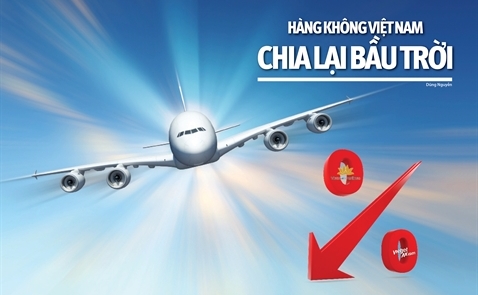Vietnam Airlines is no longer the solo player in the country's aviation market. More airlines, including newcomer Vietjet Air, have created a highly competitive market.
In Vietnam, Vietjet Air is known as a low-cost carrier (LCC) which attracts passengers with low-price tickets, while Vietnam Airlines is positioned as a traditional airline and the nation’s flag carrier.
However, analysts said that Vietjet Air is more than a budget airline. The three ticket booking websites of Vietnam Airlines and Vietjet Air shows that airfares set by Vietjet Air are not much lower than Vietnam Airlines’ tickets if counting ancillary service fees.
In principle, the airfares vary depending on the times passengers book tickets. However, Vietjet Air does not focus on the low pricing policy only.
The high numbers of flights and low costs partially explains why Vietjet Air has been succeeding in recent years, when travel demand from Vietnamese passengers has increased rapidly.
Vietjet Air positioned itself as a LCC. However, in its prospectus released earlier this year, Vietjet Air’s management board stated it would be better to avoid the competition in prices to minimize risks.
While Vietnam Airlines has SkyPriority, Vietjet Air offers SkyBoss with privileges for special passengers.
| Vietjet Air, like other LCCs in the world, has advantages in short-distance domestic air routes. In general, traditional airlines lose their market share to LCCs mostly in short-distance flights of less than 3 hours, while they hold advantage in longer-distance air routes. |
Luu Duc Khanh, managing director of Vietjet Air, recently said Vietjet doesn’t want the airline to be attached with the word ‘low-cost’ anymore. The private airline now tries to draw the public’s attention to customer experience.
Vietjet Air, like other LCCs in the world, has advantages in short-distance domestic air routes. In general, traditional airlines lose their market share to LCCs mostly in short-distance flights of less than 3 hours, while they hold advantage in longer-distance air routes. Passengers who fly often have higher incomes and accept to spend more money.
While Vietjet Air tries to march towards the high-end market, Vietnam Airlines has made heavier investments in the lower-end market through Jetstar Pacific, where it holds a 70 percent stake.
A representative of Vietnam Airlines told the local press that Vietnam Airlines will still target high-end passengers with high-quality full services, while Jetstar Pacific will target common passengers to compete directly with LCCs.
According to Vietnam Airlines, the cooperation model between Vietnam Airlines and Jetstar is based on the ‘double brand’ strategy, like the model followed by Singapore Airlines and Tiger Airways. Traditional airlines develop budget airlines of their own.
Tran Thuy / vietnamnet